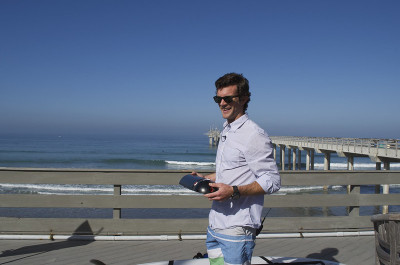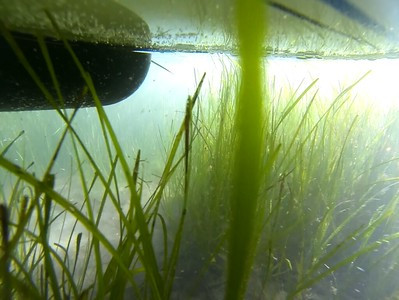Perched atop a stand-up paddleboard and navigating the waves off La Jolla, Phil Bresnahan looks like the average San Diego surfer. However, what you can’t see from the surface is that the underside of Bresnahan’s stand-up paddleboard, or SUP, has been outfitted with a custom-made pH and oxygen sensor—equipment that enables him to conduct scientific research while actively participating in a sport that he loves.
Bresnahan, a sixth-year PhD student at Scripps Institution of Oceanography, UC San Diego, spearheads the oceanographic research program SUP, Science, which came to fruition in 2013. This multifaceted science and outreach program utilizes stand-up paddleboards outfitted with sensor packages to study pH and oxygen in the surf zone and to engage the public in critical ocean and global health issues, such as ocean acidification, sea-level rise, and other topics related to climate change.
“The idea with SUP, Science is that we want to bring the sense of exploration back to people who are interested in science, specifically middle and high school kids,” said Bresnahan. “The SUP platform just seemed like a great way to engage the community here, which is such a surf-friendly culture.”

Over the past two years, nearly 100 people have participated in SUP, Science-related adventures, which take curious and eager participants beyond the walls of the classroom. SUP, Science regularly partners with the San Diego-based organizations Outdoor Outreach and Ocean Discovery Institute to educate K-12 students about ocean chemistry while also allowing them to play in the water with cool science gadgets.
“Sometimes it’s getting kids out there in the water and actually stand-up paddleboarding or kayaking with them and with the sensors, and sometimes it’s just using the platform as an attractive tool to talk about science,” said Bresnahan. “The kids are stoked. People’s faces really light up when you say that I’m a scientist and I’m doing research right now, and it looks like you’re just having a good time out on the stand-up paddleboard.”
The idea for SUP, Science originated in 2010, when Bresnahan and his friend and fellow Scripps graduate student Tim Ray talked about ways in which they could expand their outreach efforts. Both students were active volunteers with Scripps Community Outreach Program for Education (SCOPE), where they often led public tours of their labs and the Scripps campus, and gave poster presentations and demonstrations to local students and organizations.
“We wanted to get back out into the environment itself,” said Bresnahan. “We started thinking, ‘How can we do this in a way that’s scientifically motivated but also has that sense of exploration attached to it?’”
Although Bresnahan and Ray both enjoyed talking about science with the public, they wanted to find ways to get people outside and actively doing science. As kayak tours and stand-up paddleboard tours became more popular in San Diego, Bresnahan and Ray thought about leading similar outings, but with a science focus.
“We have one of the nicest coves in, maybe, the world. It’s a beautiful ecosystem,” said Bresnahan. “We said, ‘Let’s get out there and let’s see what happens when we get out in the water and talk about climate change and ocean acidification.’”
These early conversations between the two set the foundation for what would ultimately become SUP, Science.
Unexpectedly, Ray died of a heart attack in 2011 at the age of 31. Doctors later found out that he had a congenital heart defect that had been undetected.
Bresnahan was devastated by the loss of his friend. At the memorial service, he met Ray’s parents for the first time. The Ray family spoke with Bresnahan about their son’s passion for science and outreach and ways to carry on his legacy by establishing some sort of project. Shortly thereafter, with support from the Ray family and the Scripps Foundation for Science and the Environment, SUP, Science was born.
“Part of the project is to carry on this dream that Tim and I had talked about,” said Bresnahan. “His family has helped to make that possible, which is really generous.”
Support for SUP, Science allowed Bresnahan to purchase the sensor equipment needed to make coastal chemistry measurements. The custom-made WavepHOx sensor package, developed in the lab of Todd Martz at Scripps, can measure pH, oxygen, temperature, and salinity.
Although he considered other options, Bresnahan decided to use stand-up paddleboards as his main research vessel due to their unparalleled combination of portability, maneuverability, and capability in the water. Most importantly, SUPs are human powered, allowing research to take place with minimal disturbance on the environment.
Bresnahan grew up in a small town just outside of Philadelphia, and fondly remembers building model rockets with his father, a doctor, and cultivating a love for the outdoors with encouragement from his mother, a teacher. Entire summers were spent at the beach, on the Ocean City shore in New Jersey with his grandparents and two younger sisters.
A curiosity for science led Bresnahan to pursue his bachelor’s degree in chemical engineering from Lehigh University in Bethleham, Pennsylvania. During a professional development course, he was able to visit a power plant in New Jersey and see what kind of job he could get with his degree. He saw a future of working in a cubicle overlooking oil refineries, chemical processing facilities, and smoke stacks—not the future he had envisioned.

After this experience, Bresnahan started researching ways in which he could apply his chemical engineering degree to something more environmentally focused.
“When I found out that people at Scripps were building chemical sensors to study the environment, I was hooked,” said Bresnahan, intrigued by the cutting-edge research conducted at Scripps. Soon after, he applied to the PhD program and was accepted, ultimately working in the Martz Lab at Scripps.
“It has been a real pleasure to watch Phil develop as a researcher over the past five years,” said Martz, assistant professor in the Geosciences Research Division at Scripps. “As an advisor, it is a delight to see a student independently generate a new idea, like the SUP, Science project, and then actually make it happen."
As he nears the completion of his PhD program, Bresnahan is applying for postdoctoral positions. He plans to base his postdoctoral research around the idea of SUP, Science—science with a heavy outreach and education component.
Through SUP, Science, Bresnahan strives to teach people of all ages that they can make a difference in changing our planet for the better, while also learning about science through active exploration.
“It doesn’t just have to be sitting in a lab starting at a computer, wearing a white lab coat and goggles, that sort of thing,” said Bresnahan. “I want to get back to the reasons that I got interested in oceanography in the first place, which weren’t because I wanted to spend my entire life in a lab; it was because I wanted to learn something about this environment that I love so much, that I love to play in, and now love to work in.”
Recently, SUP, Science worked with Scripps Assistant Professor Andreas Andersson and 30 middle and high school students from Ocean Discovery Institute to conduct a 24-hour measurement of the water in the Kendall-Frost Reserve in Mission Bay. Students camped out overnight and assisted in collecting measurements and samples with stand-up paddleboards and kayaks every hour on the hour. Later, they analyzed the environmental, chemical, and physical parameters of the seawater samples in the Andersson Lab at Scripps.
This adventure gave the budding scientists hands-on experience both in the field and inside a research lab, where they were able to map data and see how it relates to climate change and the ability of the sea grasses down in Mission Bay to suck in the carbon dioxide.
Bresnahan hopes the Ray family is proud of his outreach work with SUP, Science, something their son Tim was also passionate about.
“I think about Tim every time I’m out there paddling,” said Bresnahan. “I definitely feel his inspiration.”
You can learn more about SUP, Science though Phil’s blog: http://agreenerblue.blogspot.com/.
Related Image Gallery: SUP, Science
Related Video: Triton's Ray
About Scripps Oceanography
Scripps Institution of Oceanography at the University of California San Diego is one of the world’s most important centers for global earth science research and education. In its second century of discovery, Scripps scientists work to understand and protect the planet, and investigate our oceans, Earth, and atmosphere to find solutions to our greatest environmental challenges. Scripps offers unparalleled education and training for the next generation of scientific and environmental leaders through its undergraduate, master’s and doctoral programs. The institution also operates a fleet of four oceanographic research vessels, and is home to Birch Aquarium at Scripps, the public exploration center that welcomes 500,000 visitors each year.
About UC San Diego
At the University of California San Diego, we embrace a culture of exploration and experimentation. Established in 1960, UC San Diego has been shaped by exceptional scholars who aren’t afraid to look deeper, challenge expectations and redefine conventional wisdom. As one of the top 15 research universities in the world, we are driving innovation and change to advance society, propel economic growth and make our world a better place. Learn more at ucsd.edu.



